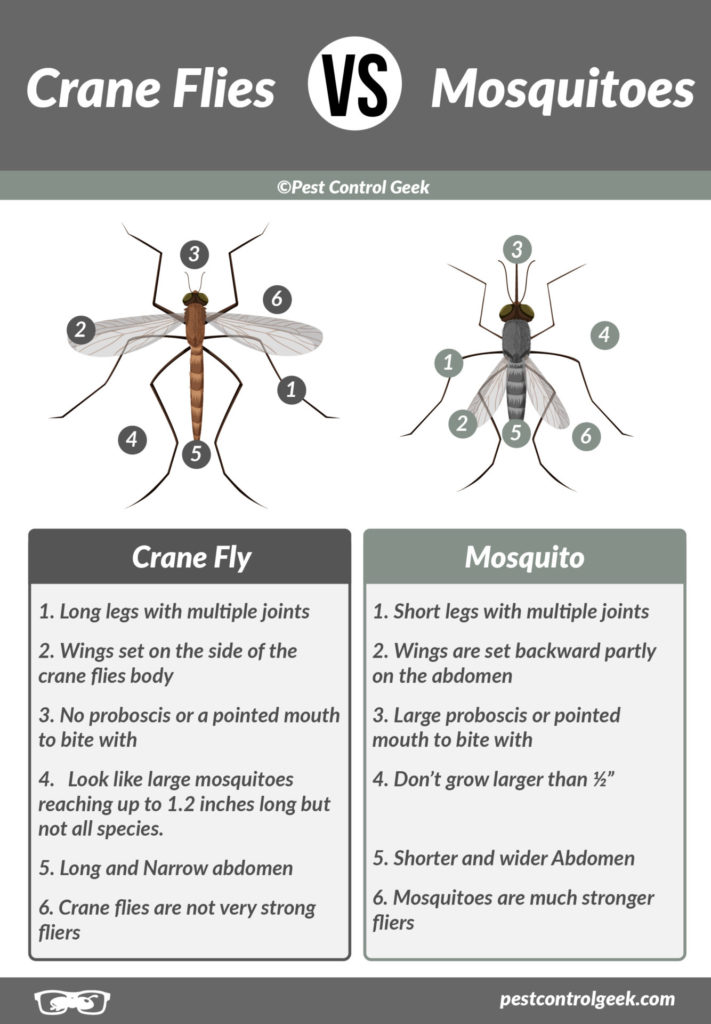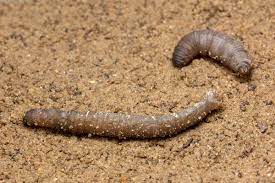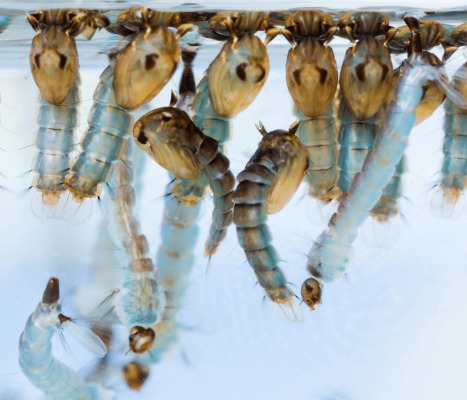Crane flies are a species of fly that resembles mosquitoes. The biggest difference in behavior between crane flies and mosquitoes is that crane flies don’t bite.
They are not capable of biting and thus are not a danger to bite or transmit any diseases.
Mosquitoes on the other hand frequently bite humans and can transmit diseases.
Crane Fly vs Mosquito
Crane flies and mosquitos are often confused because they look very similar. But, if you know what to look for, you can quickly tell them apart.
Crane flies are sometimes called mosquito hawks. This is because they are more significant than mosquitoes, and there is a misunderstanding that they eat mosquitoes. Craneflies don’t eat mosquitoes.
Size
Cranflys can vary drastically in size. The largest and most recognizable species can grow to be around 4 inches long. On the other hand, Mosquitoes are smaller than cran flies growing as large as 0.4 inches and as small as 0.1 inches long.
Diet
Crane flies do most of their eating as larvae. Depending on where the eggs are laid, they will eat food sources nearest to them. Common food sources include roots, grass, grubs, other vegetation, algae, and small insects.
Male mosquitoes feed on nectar and pollen, similar to bees. Female mosquitoes, on the other hand, feed on human blood. They need blood to reproduce.
Habitat
Adult crane flies lay their eggs in bodies of water or moist soil. After the eggs hatch, the larave remain in the same area consuming any fod sources available.
Once adults puppate and reach adults hood you will find them in low vegetation typically near bodies of water or areas of high moisture. They are also commonly found around structures.
Similar to crane flies, mosquito eggs and larvae typically live in bodies of water or soil with high moisture. Adults tend to venture away from bodies of water to find food.
Adults females tend to travel in search of humans or other mammals for a blood meal. Females require a blood meal to get the lipids and protein they need to reproduce.
What Similarities Do Crane Flies and Mosquitoes Have?
There are two key similarities between crane flies and mosquitoes:
- Appearance
- Habitat
First, crane flies and mosquitoes look very similar. They are relatively the same size, with some species of crane flies growing to be larger than most mosquitoes.
Both insects have a pair of wings with six legs. Both also have a long abdomen although the abdomen of the cranefly is thinner and longer than mosquitoes.
Second, both crane flies and mosquitoes tend to lay their eggs in similar environmental locations. Both target bodies of water or high moisture areas.
As adults, you will also find that they are both attracted to light so they tend to congregate around structures at night. During the day, you will likely see male mosquitoes and crane flies around flowers and trees in search of nectar to eat.
How To Tell Crane flies and Mosquitoes Apart?

Yes, crane flies and mosquitoes look very similar but there are a few things you can look for to help you tell them apart.
- Legs: Crane flies have longer legs that have multiple joints (bends)
- Wings: The wings of crane flies are on their side while mosquitoes’ wings are set backward or directly above their abdomen.
- Proboscis: Crane flies don’t have proboscis or a pointed mouth to bite humans and other mammals.
- Size: Crane flies tend to be larger but this is not true for all species. Mosquitoes don’t reach sizes larger than ½ inch long.
- Abdomen: Crane flies have a longer and narrower abdomen than mosquitoes.
- Flying: Crane flies are not very strong fliers while mosquitoes are much stronger fliers that can easily get to their desired destination. The strong-flying ability of mosquitos is often the reason for the success of biting people.
Crane Fly Larva Vs Mosquito Larva
What Do Crane Fly Larva Do?

Crane fly larvas spend most of their time feeding on organic matter such as small insects, grass, roots, algae, and any other organic matter they can get their hands on.
The crane fly spends most of its time in the larva stage. The larva lives in bodies of water or in moist soil.
Here they spend most of their time eating vegetation, algae, small insects, and other insect larvae.
The larva is beneficial to the environment because they eat decaying organic matter. Areas with large populations typically have an improved biological decomposition and improve the life cycle of plants and flowers in the area.
What Do Mosquito Larva do?

Mosquito larva spends their entire lives inside bodies of water. In the water,, they spend their time eating plankton, fungi, algae, and other micro-organisms.
Compared to crane fly larva, mosquito larva are not as beneficial. They are helpful in several ways
- They are a nutritious snack for fish and other animals inside the water
- They feed on waste to improve decomposition in bodies of water
- Make nutrients available inside water, such as nitrogen
What Attracts Crane flies?
Crane flies are attracted to moisture, light, and nectar.
Female crane flies will search for locations with high moisture or bodies of water to lay their eggs.
These conditions ensure that their eggs will survive and that the larva will have food to survive on.
Male crane flies are attracted to females and nectar. Tyically, after mating the males will proceed to looking for food and waiting until they die.
Both male and adult crane flies are also attracted to light. This is the reason they are often found outside of structures at night.
Crane fly larva are attracted to mosisutre and decaying organic matter. They spend most of their life as larva so it’s important that they are in ideal environmental conditions to ensure they reach the adult stage and they can continue growing their population.
The larva will consume decaying organic matter, other small insect larva, algae, and other bacteria.
Frequently Asked Questions
What Are Crane Flies?
Yes, crane flies can fly. Although, they are not very strong fliers. There are often found on the floor struggling to pass if there is heavy wind or if they have been swatted.
Ideal conditions for crane flies to fly include high humidity with low wings and no rain. When there are slight winds, crane flies will often get carried by the currents.
Do Cranflies Eat Mosquitoes?
No, crane flies don’t eat mosquitoes. They often get the name mosquito hawk or mosquito eater because they are larger. The fact is that they don’t eat mosquitoes.
Crane flies actually don’t have a mouth capable of biting. They spend their adult life mating, laying eggs, and eventually die. In most cases, adults-only live one month and rarely eat before dying.
What Do Crane Flies Eat?
Adult crane flies typically feed on nectar and pollen similar to male mosquitoes. They also tend to consume the honey dew that insects such as aphids produce.
You are likely to find craneflies consuming sweet liquids that will help them survive. There are also reports of them feeding on the nectar on hummingbird feeders.
Adult crane flies don’t have mandibles that allow them to bite or chew. They have an elongated moth that is better for eating or sucking liquids.
It’s important to note that although they have an elongated mouth it’s not capable of breaking human skin.
Do Crane flies bite?
Crane flies don’t bite or sting humans. Unlike, their doppelganger the mosquito that is known for their itchy bites.
You might see crane flies around structures because they are attracted to light. Similar to mosquitoes, crane flies are attracted to light which is the reason they tend to be found near homes and other places that humans live.
Are Crane flies dangerous?
No, crane flies are not dangerous to humans or animals. They don’t bite or sting humans because they don’t have mouthparts capable of breaking through human skin.
They pose no threat of transmitting any diseases through bites or direct contact with humans.
If crane flies around your home, you can feel sure that they are not dangerous for yourself, your family, or pets.
Are Mosquito Hawks and Crane Flies The Same Thing?
Yes, crane flies are often referred to as mosquito hawks. Due to their large size, it’s often thought that crane flies eat mosquitoes.
This is a common misconception crane flies don’t eat mosquitos.
Although they do look very similar to mosquitoes, they don’t eat or bite like mosquitos. Crane flies are a species of fly that happens to look very similar to mosquitoes but follow all the same habits as other soil-dwelling flies, such as cluster flies.
Should I Kill Crane Flies?
No, there is no need to kill crane flies. These flies are harmless to humans and other animals. While they can be a nuisance and unsightly around your home, there is no need to kill them.
Crane flies only live a maximum of 30 days, and most die off after 10 to 15 days. This means that you can easily wait for the crane flies to die off around your home.
To avoid them from coming back, you need to eliminate areas where they can lay their eggs. The key to preventing crane flies is to reduce moisture around your home. This includes excess moisture as well as bodies of water.
How Long Do Crane Flies Live?
Adult crane flies live on average between 10 and 15 days. They can live a maximum of 30 days before they die.
Adults spend their short lives with two goals in mind:
Reproducing
Looking for shelter for their eggs
Crane-fly eggs hatch on average between 5 and 15 days. The eggs are typically places in bodies of water or areas of high moisture.
Crane flies spend most of their lives in the larva stage. It’s expected that they spend approximately 95% of their lives as larva. They can stay in the larva stage for as long as three years, depending on the conditions.
